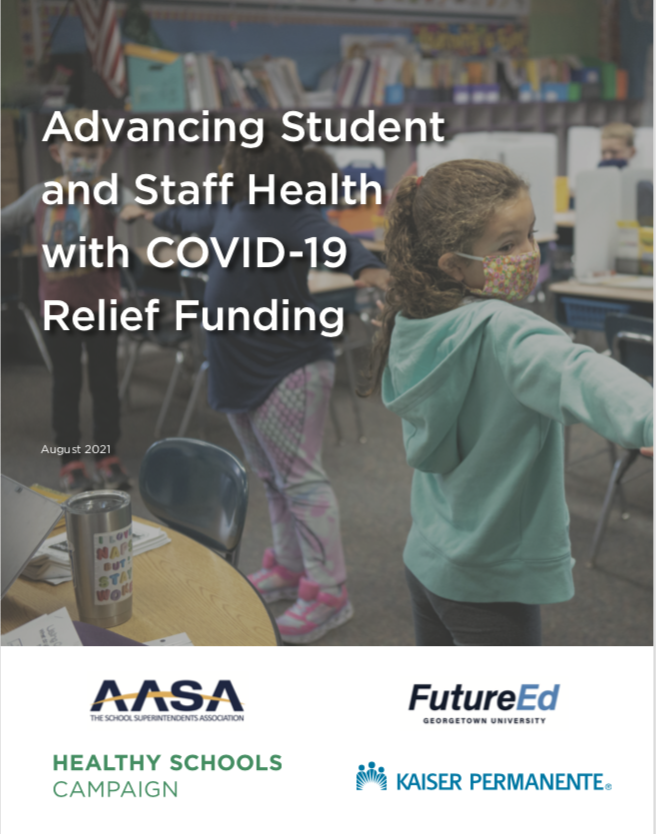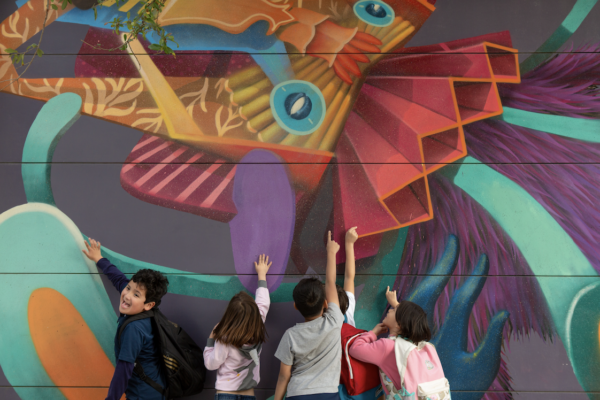For all the talk about the pandemic’s impact on academic achievement, the coronavirus crisis remains at its core a public health emergency, one that schools will have to address before they can begin helping students recover from lost learning opportunities. A new analysis by the Healthy Schools Campaign, FutureEd, The Superintendents Association (AASA), and Kaiser Permanente shares how the influx of federal aid for public schools, totaling nearly $190 billion approved over the past 15 months, can help schools and districts navigate two key health priorities.
The first is ensuring that buildings are safe and healthy environments for students to learn and educators to teach. This is  particularly important with COVID cases surging again and many families worried about sending their unvaccinated children back to in-person classrooms. To keep them safe, the Centers for Disease Control and Prevention has renewed its recommendations for wearing masks inside schools and recommends that schools and districts continue to provide the protective equipment, physical space, and contact-tracing needed to contain the spread of the virus.
particularly important with COVID cases surging again and many families worried about sending their unvaccinated children back to in-person classrooms. To keep them safe, the Centers for Disease Control and Prevention has renewed its recommendations for wearing masks inside schools and recommends that schools and districts continue to provide the protective equipment, physical space, and contact-tracing needed to contain the spread of the virus.
The second priority is addressing the broader health needs of children, particularly mental health concerns, so that students can recover from both the academic and social-emotional effects of the pandemic. Research and experience tell us that healthy students are better learners. They attend school more regularly, focus better in class and develop strong relationships with peers and teachers.
[Read More: Advance Student and Staff Health with COVID-19 Relief Funding]
Recognizing these health needs is particularly important for children from disadvantaged backgrounds, many of whom have experienced the worst of the pandemic. Many children haven’t seen a doctor in the past year, missing regular well-child visits. An estimated one in five students have missed key vaccinations they need to prevent childhood diseases. Other children have gone hungry when parents lost jobs and wages needed to support the family. And many others have suffered trauma from losing loved ones, moving to a new home, or simply losing touch with friends and teachers.
Those who have been learning from home have gotten out of the habit of interacting regularly with other students, a reality that could manifest in anxiety and behavioral problems when they come back to the classroom. Many have missed weeks if not months of school. Again, the most vulnerable students are often hardest hit by these problems. They are more likely to have suffered hunger and trauma, less likely to have seen a doctor, more likely to be chronically absent, and more likely to have remained in remote learning settings over the past year.
Fortunately, the COVID relief aid approved by Congress offers schools districts and states wide latitude to support student health and equity concerns. All three of the relief packages approved since March 2020 specifically mention safe and health school environments, student mental health, and reengaging students and families as top priorities.
[Read More: Covid Relief Playbook: Smart Strategies for Investing Federal Funding]
Likewise, the U.S. Education Department requires states to lay out COVID mitigation efforts and strategies for addressing social-emotional health before receiving full funding from the American Rescue Plan. The relief aid can be combined with other resources—federal, state or local—to deliver what students and staff members need.
Many districts and states are already hiring additional school nurses and mental health counselors to address student and staff needs. Education leaders, though, need to be mindful that the federal dollars will run out by late 2024, leaving districts to come up with the money to pay additional staff members. A more sustainable approach could be to hire short-term workers who can support contact tracing and health screening or work as mentors for students who need extra attention. The extra funding for national service programs such as AmeriCorps could be a source of such workers.
The new analysis outlines a number of other strategies that schools and school districts could pursue, including:
- Expand the equipment and training needed for the use of telehealth to provide students access to mental health counseling and physical checkups through remote networks. This could be a particularly effective strategy in rural communities, which often have a shortage of providers and long drive times to get to appointments.
- Adopt a Community Schools model that brings together other agencies and local nonprofit organization to address the needs of students and families. COVID relief dollars can support the costs of a school-based coordinator
- Conduct a schoolwide mental health assessment to gauge the trauma experienced by students and staff members and determine what services are needed.
- Launch a back-to-school campaign that includes immunization clinics to ensure more student are up to date on their shots, as well as outreach to enroll all eligible students in Medicaid or CHIP.
- Develop social-emotional learning programs that improve a school’s climate and training staff members on interventions, such as restoratives practices, that can resolve conflicts and behavioral issues at school without turning to suspensions.
- Create school-based health centers, which can keep students healthier and thwart the spread of Covid and other infectious diseases.
- Invest in better tracking of student health data to identify future needs and support reimbursement for Medicaid expenses, when applicable.
- Upgrade school ventilation systems both to reduce the spread of Covid-19 and improve student health. Poor air quality can lead to greater absences among students with asthma and allergies; likewise, buildings that are too hot or too cold can make it harder for learning to happen.
Equity should drive this work: Schools, districts and local health officials should recognize the disproportionate harm that the coronavirus crisis has done to disadvantaged students and their families. Spent wisely, this infusion of federal funding can not only help students recover from the pandemic’s disruption but can also fix some of systemic health challenges that have kept these students from succeeding in the past.
Don’t Miss: Sept. 21 Webinar: School Districts and Covid Relief Funding


